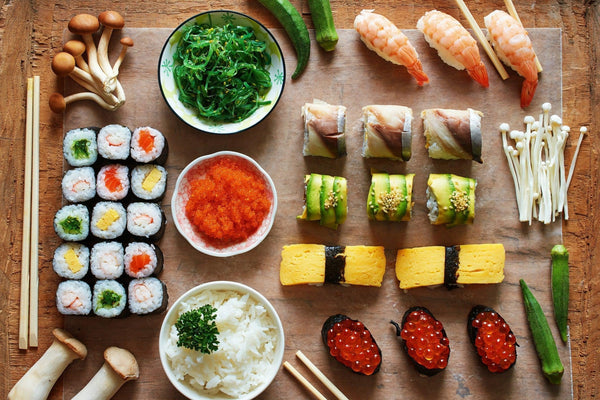
Jump to:
Arguably the most famous of all Japanese cuisine, sushi is a popular delicacy enjoyed by people all over the world. Whether you're a sushi lover or just looking for a unique and fun way to entertain your guests, hosting a sushi party at home can be a fun way to spend time with your friends and family.
Sushi’s origins can be traced all the way back to ancient Japan, where the first kind of sushi, narezushi, was first developed as a way of preserving fish. The fish was salted and packed in rice, and left to ferment for several months, allowing it to be preserved for long periods of time, and the rice was discarded before consumption. Sushi evolved over time and today you can find many varieties of sushi rolls and dishes all over the world.
The idea of making sushi from scratch may initially seem daunting, especially if you've never done it before. In this article, we'll provide you with tips and guidelines on how to make sushi at home and throw a party that will leave your guests raving about it for months!
From the essential tools you’ll need, to serving the right condiments and drinks, we'll guide you through each step to help you create an unforgettable sushi party. So, let's get started and learn how to throw the ultimate sushi party at home!
How To Prep For Your Sushi Party – Shopping List & Kitchen Essentials
What Do You Need For A Sushi Party?
Aside from the food and drink you will serve, here are a few essential kitchen items you should have as part of your sushi-making kit to make your party a success:
Sashimi Knife

When it comes to preparing sushi, a good knife is an essential item. Known as a yanagiba in Japanese, this traditional Japanese knife is designed especially for slicing boneless filets of fish to prepare sashimi.
A yanagiba knife has a long narrow blade, is extremely sharp, and is ideal for cutting through raw fish in one single slicing motion. This design allows the fish to retain its flavor and texture without being damaged by the knife.
Rolling Mat

If you’re planning to make any kind of sushi roll, you’ll want a rolling mat. Known as "makisu" in Japanese, traditional sushi mats are made from bamboo, however you can also find plastic and silicone mats too, which are easy to clean after use.
Sushi Making Device

This sushi making device helps to make light work of preparing well-presented nigiri sushi at home. This simple sushi maker is great value for money and stops the sushi rice from sticking to any surface, creating beautifully presented and delicious nigiri sushi every time.
Oke Wooden Bowl

This beautifully crafted Sushi Oke or Hangiri Bowl is an essential Japanese cookware item for correctly preparing sushi rice. The characteristics of the wood and the wide shape of the bowl quickly cool the hot rice and remove any excess water. You can use this product to make perfect sushi rice every time by mixing boiled rice with sushi vinegar directly in the bowl.
Ingredients And Condiments
Now you have the right tools you need for making high-quality sushi, next, let’s focus on the ingredients. Here are a few essentials you’ll need:
Sushi Rice

It would be easy to assume that when it comes to making good sushi, the most important ingredient is the quality of the seafood used, however, the sushi rice and nori (seaweed) are equally important in achieving a good quality sushi roll.
Sushi rice is short-grain Japanese rice seasoned with vinegar, salt, and sugar. You can learn how to make sushi rice at home in our article here.
Rice Vinegar

When it comes to making sushi rice at home, using high-quality sushi vinegar is extremely important and has a significant impact in determining what makes a good piece of sushi. This premium sushi rice vinegar from Uchibori includes kombu seaweed for added umami flavor and has a mild, sweet taste.
Sushi Nori

Nori is a kind of edible seaweed and a key ingredient in sushi rolls. Available to purchase in sheet form, toasted nori sheets are easy to cut, have a crispy texture, and umami flavor. You can also buy nori sheets packaged in plastic film which are easy to use when wrapping sushi rolls. You can read more about nori in this article.
If you’re looking to buy some high-quality nori, check out this 50-count pack of nori seaweed from Daihoku. Sourced from Japan’s Ariake oceanside region, this nori is picked at the beginning of the harvest season, when the seaweed is normally at its best quality.
Fillings/Toppings

When it comes to the fillings for your sushi rolls or the toppings for your nigiri or chirashi sushi, the choices are endless. Decide before you go shopping what kind of sushi you would like to serve and make a list of the ingredients you will need. Here are a few popular ideas to get started with:
Tuna: Tuna is a common filling for sushi rolls and can be used in both raw and cooked forms.
Salmon: Salmon is another popular filling for sushi rolls and is often used in its raw form.
Crab: Crab meat, either cooked or imitation, is a popular filling for sushi rolls, particularly in California rolls.
Avocado: Avocado is a vegetarian-friendly filling option for sushi rolls and is often combined with other ingredients such as cucumber and carrots.
Cucumber: Cucumber is a refreshing and crunchy filling option for sushi rolls and is often paired with other vegetables and seafood.
Shrimp: Cooked shrimp is a popular filling for sushi rolls, particularly in shrimp tempura rolls.
Eel: Unagi, or freshwater eel, is a common filling for sushi rolls and is often served with a sweet sauce.
Cream cheese: Cream cheese is a unique filling option for sushi rolls, particularly in Western-style rolls such as Philadelphia rolls.
Condiments

Here are a few essential condiments you’ll also need to purchase:
Soy sauce or tamari – used as a dipping sauce and typically served separately in a small dish, a good quality soy sauce or tamari is a must-have sushi condiment. Check out our article on the best Japanese soy sauces to find one that best suits your needs.
Wasabi – to help bring out the flavor of sashimi, dab a piece of sushi in wasabi (a little goes a long way!) We recommend this Kameya Coarsely Grated Wasabi Paste, which unlike most wasabi pastes that use western horseradish, is made from 100% Japanese wasabi produced in Shizuoka.
Pickled ginger – often served with sushi to help bring out the flavor and as a palate cleanser.
Making Sushi From Scratch – 5 Tips & Techniques For The Perfect Roll

When it comes to making sushi from scratch for the first time, there are tons of online videos and tutorials you can check out to help make the process easier. Just remember to be patient and have fun, and don't be afraid to experiment with different fillings and flavors! Here are a few tips to set you up for sushi-rolling success:
- Use a sushi mat. A bamboo sushi mat makes it easier to roll the sushi tightly and evenly. Cover the mat with plastic wrap to prevent the rice from sticking.
- Spread the rice evenly. Use a wet spoon to spread the rice evenly over the nori, leaving a small border around the edges.
- Don’t overstuff. Be creative with your fillings but avoid overfilling the roll. Use a combination of colors and textures for the best results.
- Roll the sushi tightly. Use the sushi mat to roll the sushi tightly and use a little pressure to make sure the filling stays in place.
- Cut the sushi properly. Use a sharp knife to cut the sushi roll into even pieces. Dip the knife in water before each cut to prevent the rice from sticking.
Create Your Own DIY Sushi Bar
For a fun group experience, why not set up a sushi bar where everyone can try their hand at making sushi rolls? Here are some ideas for a few different kinds of sushi you can make that would work well in a party setting.
Nigiri

Nigiri is probably what most people think of when we picture traditional sushi. The sushi rice is shaped by hand and topped with raw fish or other ingredients. Popular examples of nigiri include tuna, salmon, and yellowtail.
Temakizushi (Hand Rolls)

Maki sushi is bite-sized tubular-shaped sushi rolls containing rice and fillings, all held together by a sheet of nori seaweed. Popular fillings include raw fish like salmon and tuna, crab, and vegetables like avocado and cucumber. These kinds of sushi rolls are very easy to make as no rolling or bamboo mat is required.
Temari Sushi

Temari sushi are small round balls of sushi rice topped with your preferred ingredients. They usually look quite colorful and decorative in appearance and are popular to share during special occasions and holidays. You don’t need any special ingredients or equipment for making temari sushi, but a pair of tweezers are useful when it comes to placing the toppings on the rice.
Hosomaki

Hosomaki are a type of thin sushi roll wrapped in nori seaweed rolled on a bamboo mat. They are bite-sized and usually consist of nori, rice, and just one ingredient, a vegetable or piece of seafood.
Futomaki

"Futomaki" literally means "thick roll" in Japanese. Held together by a piece of nori, they are usually larger than other types of sushi rolls, and they can be cut into several pieces before serving. If you’re making this kind of sushi, consider adding some kanpyou strips as a filling, a plant-based ingredient often found in futomaki.
Uramaki

Uramaki sushi is like futomaki, but with one major difference: the rice is on the outside of the roll, and the nori is on the inside. "Uramaki" literally means "inside-out roll" in Japanese.
To make uramaki sushi, a sheet of nori is first placed on a sushi mat, and sushi rice is spread over the nori. The fillings are then arranged on top of the rice, and the roll is then wrapped with the nori on the inside and the rice on the outside. This is often sprinkled with sesame seeds or tobiko (flying fish roe) for added texture and flavor.
Uramaki sushi is also commonly known as "California roll" in the United States, as it was originally created there in the 1960s.
Chirashi Sushi

Chirashi sushi is often served in a bowl or box, rather than rolled into a cylindrical shape like other types of sushi. "Chirashi" literally means "scattered" in Japanese, and this refers to the way the sushi ingredients are scattered or arranged on top of a bed of sushi rice.
To make chirashi sushi, a layer of sushi rice is first placed in a bowl or box, and then a variety of toppings are added on top of the rice. The toppings can include raw or cooked seafood (such as tuna, salmon, or shrimp), vegetables (like cucumber or avocado), egg, and sometimes even fruit. The toppings are often arranged in a decorative manner to make the dish visually appealing.
Chirashi sushi is popular because it allows for a lot of creativity and customization in terms of the toppings. It can be served as a main dish or as part of a larger meal, and it’s a great option for sushi lovers who may not be confident in their ability to roll sushi, as it requires less technical skill but still offers all the delicious flavors and textures of sushi. Add this chirashi seasoning to your dishes for extra authenticity along with these kinshi tamago shredded egg strips. If you want to make chirashi sushi at home, then check out our recipe.
Drinks to Serve at A Sushi Party

If you want to extend the authentic Japanese theme to your party drinks as well, here are a few ideas for Japanese beverages you can serve to your guests:
Alcoholic Drink Ideas
You could try serving sake, umeshu, Japanese beer, or a cocktail with a Japanese twist that features ingredients such as matcha or yuzu. If you’re new to the world of Japanese sake, this Tsuki no Katsura Houfukuzettou Japanese Premium Handmade Sweet Sake from Kyoto is sweeter than other traditional sakes and can be described as a sake halfway between traditional sake and white wine.
Non-Alcoholic Drink Ideas
Green tea – usually served with sushi as a palate cleanser and to help with digestion. You can learn more about the best Japanese green tea brands in this article.
Ginger ale – this famous Japanese non-alcoholic ginger ale has a refreshing taste and mellow flavor that is sure to be a hit with your guests.
Ramune – is a popular Japanese soda available in a variety of flavors. The original version is a lemon-lime flavor which is very popular among Japanese consumers.
Setting The Atmosphere

Now you have all your food and drink prepared, it’s time to add the final touches to create the perfect party atmosphere. You could create a Japan-themed Spotify playlist for background music or burn some Japanese incense to create a relaxing atmosphere.
If you want to go that little bit extra, use Japanese tableware such as small plates, cups, and chopsticks to serve up your sushi. Some of our favorite items include these sushi-themed porcelain tea mugs and these elegantly designed stainless steel Japanese chopsticks.
All that’s left now is for you to have a great sushi party – enjoy!


0 comments